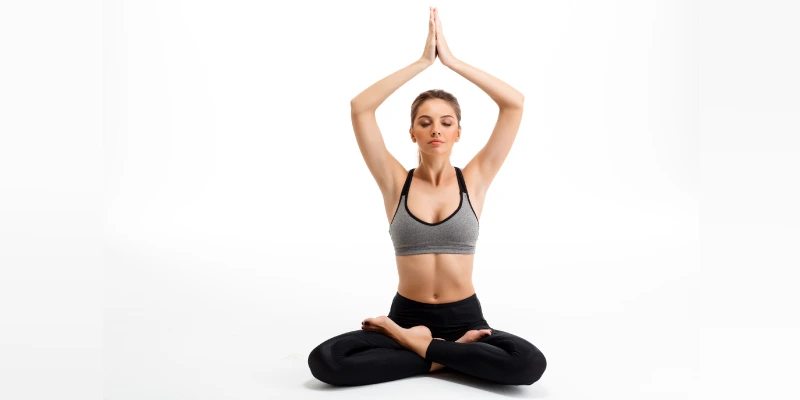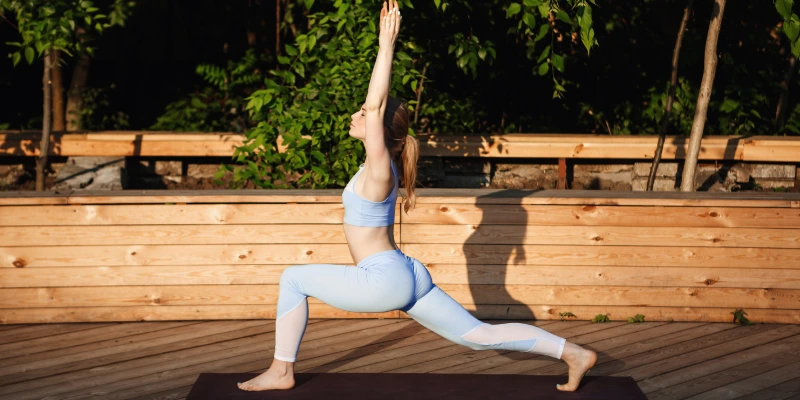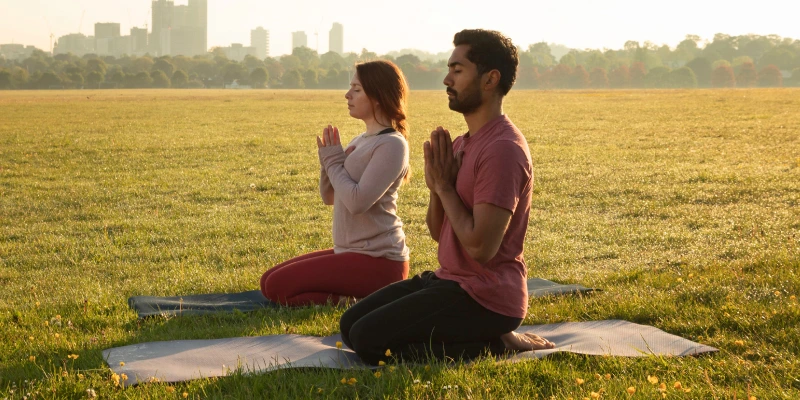It’s time to roll out your yoga mats and discover the combination of physical & mental exercises that have hooked yoga practitioners around the globe. The beauty of yoga lies in the fact that you needn’t be a ‘yogi’ or a ‘yogini’ to reap the benefits.
Whether you are young, old, or overweight – yoga can calm the mind and strengthen the body. Even studies show that over 77% were physically fit after doing yoga.
But the first thing to do is, don’t be intimidated by the yoga terminology, complicated yoga poses, and fancy yoga studios. Therefore, Yoga is for everyone and can be done anywhere, not just in studios!
In today’s guide to yoga, we will deal with the benefits and the best yoga poses to try if you are a beginner.
So, bookmark this blog, as we will also tell you some amazing poses you can begin your yoga sessions with!

What Is Yoga?
Yoga originates from the Sanskrit word meaning ‘UNION’ or ‘YOKE’. In layman’s terms, yoke means to draw together, to bind together, and to unite. Thus, the main aim of yoga is to create a union of the body, mind, soul, & universal consciousness.
Basically, it is the process of uniting our physical, mental, emotional, and spiritual aspects to achieve peace, self-realization, and experience a deep state of freedom!
Yoga is an ancient system passed down to us through our previous generations. Moreover, many yogic practices include deep breathing, postures, chanting, meditation, and much more!
Moreover, Patanjali’s Yoga Sutras is one of the famous texts depicting the fundamentals of yoga. In addition, the cessation of thoughts results from the dedicated & consistent practice of yoga. So, by calming our mental chatter, this contemplative exercise connects us to the source of our being and unites us with everything around us!
Goals Of Yoga
Yoga is a meditative process of liberation & self-discovery. In addition, it is a diverse collection of practices aiming to control the mind and offer the experience of freedom. The goals of yoga are as follows:
- It provides mental clarity.
- It helps us to be aware of our feelings, thoughts, and beliefs and to change the ones that no longer serve us.
- It offers us the tools, thus enabling us to make better choices in life and live fully.
- It purifies our body, mind, and soul.
- It helps us acquire self-awareness, acceptance, compassion, patience, forgiveness, humility, love, peace, joy, etc.

Limbs Of Yoga
The fundamentals of yoga describe eight limbs to reach the desired goal. Each limb of yoga includes a spiritual, mental, and physical practice that builds upon one another. So, the eight limbs are:
- Yama
The moral codes of conduct.
- Niyama
The internal practices and physical observances.
- Asana
The proper posture.
- Pranayama
The proper breathing exercises.
- Pratyahara
The withdrawal of senses from external distractions.
- Dharana
Focussing the mind & mental concentration.
- Dhyana
Focusing on a single point.
- Samadhi
The cessation of the mental activity to attain the state of oneness.
Also Read: Science Of Happiness

Guide To Yoga – Yoga Postures You Need To Know
The building blocks of yoga are poses or postures. Therefore, it is vital to learn them and begin on the path of consistent yoga practice.
The poses mentioned below are a beginner’s guide to yoga. But they are a complete workout. So, it is advised to move slowly through each pose. Also, pause immediately if you find a particular pose challenging.
The idea is to hold the pose briefly before moving on to the next one!
- Child’s Pose
The first pose in this guide to yoga is the child’s pose. This calming pose helps you rest & refocus before you move on to your next pose. Moreover, it gently stretches your lower back, hips, thighs, and knees and relaxes your spine, shoulders, and neck. Here are some key points to note:
- Do it when you want to stretch through the neck, spine & hips.
- Skip this pose if you have knee injuries or ankle problems. Also, avoid it if you have high BP.
- Lastly, be mindful and focus on relaxing the spine and lower back muscles as you breathe.
- Downward Facing Dog Pose
Downward-facing dog strengthens the arms, shoulders, & back while stretching your feet’ hamstrings, calves, and arches. It can also help you relieve back pain.
- It helps relieve back pain.
- This pose isn’t recommended if you have wrist problems, high blood pressure, or are in the later stages of pregnancy.
- However, you can modify the pose using blocks under your hands or elbows on the ground. This takes the weight off your wrists.
- So, the idea is to distribute the weight evenly through your palms, lifting your hips and back away from the shoulders.
- Plank Pose
While it is a commonly seen exercise, this pose helps build strength in the core, legs, arms, and shoulders.
- The plank pose is suitable for toning your abs and building strength in your upper body.
- Moreover, it is best to avoid it if you have carpal tunnel syndrome and back pain.
- You can also do this pose by placing your knees on the floor.
- As you do this pose, imagine the back of your spine and neck lengthening.
- Cobra Pose
One of the perfect poses in this guide to yoga is the cobra pose. In addition, this back-bending pose helps strengthen the back muscles, increases spinal flexibility, and stretches the chest, abdomen, and shoulders.
- This pose is best for strengthening the back.
- If you have arthritis in your neck or spine, try to avoid it. Moreover, if there’s some lower back injury, don’t do it!
- For your comfort, you can lift just a few inches. But refrain from straightening your arms.
- As you hold this pose, keep your navel away from the floor.
- Tree Pose
Tree pose is an integral part of yoga guide to beginners as it helps improve your balance and strengthen your ankles, calves, thighs, spine, and core.
- This pose is excellent for working on your balance and posture.
- But you must skip it if you have low blood pressure or any medical conditions affecting your balance.
- Moreover, you can modify this pose by placing your hands on the wall for support.
- Also, try to focus on the breath in and out as you pose.
- Triangle Pose
Triangle, a part of many yogic techniques, helps build strength in the legs & stretches the hips, chest, groin, shoulders, calves, and hamstrings. It also helps increase mobility in the hips and the neck.
- This pose is excellent for building strength and endurance.
- One must not do this pose while having a headache or low blood pressure.
- Moreover, if you have high BP, you can turn your head to gaze downward. Similarly, if you have neck problems, don’t turn your head to look upward. Instead, look straight ahead and keep both sides of the neck long.
- Keep stretching your hand towards the ceiling. It will help keep the pose buoyant.

Revive Your Spirit!
Patience, commitment, repetition, and consistency are critical to developing and progressing on the path of yoga. This guide to yoga featured the top six yoga postures for beginners. In addition, after you have practiced these poses for a certain period of time, don’t forget to follow these tips:
- Attend yoga classes or practice at home consistently.
- Increase the length of your practice & the number of days per week you practice, thus gaining as much experience as possible.
- Attend several yoga workshops that focus on particular yoga aspects.
- Journal the effects of yoga on your body, mind, and soul.
- Read more and more about yoga practices and try to implement them.
- Finally, adopt a yogic lifestyle.
Yoga unites your body, mind, & soul and offers you a new perspective and enhanced awareness.
So, tell us in the comments below what positive effects yoga has brought into your lives!
Also Read: Stress Management Techniques









